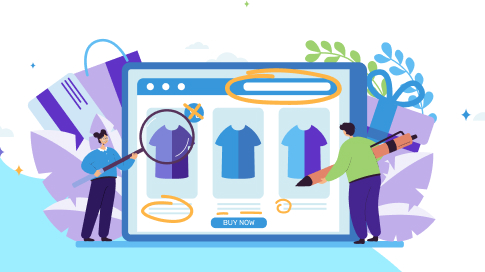5 Shopify Marketing Strategies To Skyrocket Sales for Startups
Shopify’s intuitive platform has made getting a quality eCommerce store up and running easier than ever. However, it’s also created a highly competitive market where merchants must go the extra mile to achieve their sales targets. To stimulate sales and maximize your store’s potential, you need to combine the Shopify platform’s tools and long-standing eCommerce marketing concepts to bridge the gap between your products and your target consumers. Here are four of the most effective Shopify marketing strategies to help your startup skyrocket sales.
Prioritize User Experience Optimization
The user experience (UX) you provide on your Shopify site is crucial to your overall marketing, allowing customers to explore your categories seamlessly and encouraging them to return to your store when they’re looking for products like yours. Before you can think about optimizing your Shopify marketing with new features and embellishments, it’s important to build a baseline of site optimizations that you can develop later.
Some of the basic best practices of Shopify site design include:
- Using responsive and well-reputed themes that ensure fast loading and an easy browsing experience on all devices. You don’t want to drive away a large chunk of your audience simply because they’re trying to browse your store on a device that you haven’t accounted for.
- Use a system font that reflects your brand identity but is still common enough to ensure most of the people who come to browse your store won’t have to download additional elements to access all elements of your site.
- Assess the layout of pages where most of your traffic is entering your site and make sure they’re free of unnecessary or distracting above-the-fold elements. These can prevent site visitors from moving to the next stage of the buyer journey as they would naturally when visiting an eCommerce store with a more conventional design.
Work On Your Product Pages
Optimizing your Shopify store for conversion can cover many different elements, but one of the most crucial to get right is your product pages. These will be one of the last stages your site visitors will reach before converting, and a simple slip-up in design can easily lose you a sale. It can be easy to let product pages fall by the wayside in the course of broader site optimization drives, so, consider setting some time aside to review the key elements of your product detail pages (PDPs).
Some key things to think about are:
Clarity of Important Elements
The product price, features, color options, size, and anything else your customers are likely to be most interested in should be prominently displayed and easily absorbed at a glance. If your customers have to scroll or search your PDP to find the basic details of a given product, you’ll have a hard time convincing them this product is worth their precious time.
The Design and Placement of Your CTA
Like the other important elements of your product detail pages, your call-to-actions (CTAs) must be prominently displayed and designed in a way that’s conducive to a positive user experience. When designing your CTAs, be sure to choose a color that works with the rest of your theme but still contrasts the dominant palate enough to stand out.
It’s also best to use familiar and traditional button text like “add to cart” or “buy now”.
Quality of Imagery
Even with the growing role of augmented reality in eCommerce helping customers to make more informed purchase decisions, one of the inherent weaknesses of eCommerce is that it doesn’t allow shoppers to get as closely acquainted with your products when compared to brick-and-mortar stores.
To offset this, make sure you’re using the highest-quality imagery possible, using professional product photography and enhancements to give your audience a clear idea of what they’re buying.
PDP Copy
SEO optimization on your product pages can make you infinitely more discoverable. However, you should never let having a high keyword density get in the way of a positive user experience. Ensure your copy is detailed, informative, and concise enough that your site visitors can absorb the product’s main USPs quickly and easily.
Shopify Marketing – Use Pop-Ups Wisely
Using pop-ups is often cited among effective Shopify marketing strategies, helping to keep a cap on your bounce rate and build customer loyalty over time. However, taking the wrong approach to this tool can easily become more of a hindrance than a help.
Here are a few key pieces of advice for applying pop-ups within your eCommerce store and making sure they don’t bring down the quality of your user experience:
- Offer your site visitors a tangible incentive to interact with your pop-ups, for example, a percentage off their first order.
- Give a clear and easy way to exit the pop-up. No one likes being stuck on a new window when they’re in the middle of browsing a store.
- Align the way your pop-ups are triggered with your typical customer journey. If your users are seeing too many pop-ups too often, they’ll become annoyed and be less likely to purchase.
- Keep any pop-up forms simple. Gathering customer information like emails with which to share discounts and deals can be a great way to stimulate future marketing drives. Keep in mind that if your visitors have to fill in too many fields, they’re less likely to interact with your pop-ups.
- Look for ways to personalize pop-ups to make repeat customers feel appreciated or advertise new products and offers to people who are most likely to convert.
Start and Develop a Loyalty Program
Building an effective customer loyalty program is one of the best things you can do to maximize the value of your customer base and generate more sales without having to strain your resources on drives for new customer acquisition. The secret to an effective loyalty program is having compelling incentives, such as:
- Early access to new launches
- Exclusive sales events
- A points system that rewards customers for making purchases
It might also be worth incentivizing certain actions like referring new customers, sharing social media promotions, or leaving product reviews. Ensure your loyalty program has diverse incentives tailored to your audience segments and is informed by customers’ purchase behavior who have consistently shown the best lifetime value (LTV) in your store. This will maximize your chances of people signing up for your programs and using its features consistently as they shop with you.
Shopify Marketing Strategies – Supercharge Your Shopify Sales
Developing a Shopify site that delights your customers with a UX-informed design, compelling projects, and attractive auxiliary features will help you build a compelling shopping experience that moves more products and builds a more solid customer base. We hope these strategies serve you well as you develop your Shopify store and work towards making your mark in the competitive Shopify market.




Leave a Reply